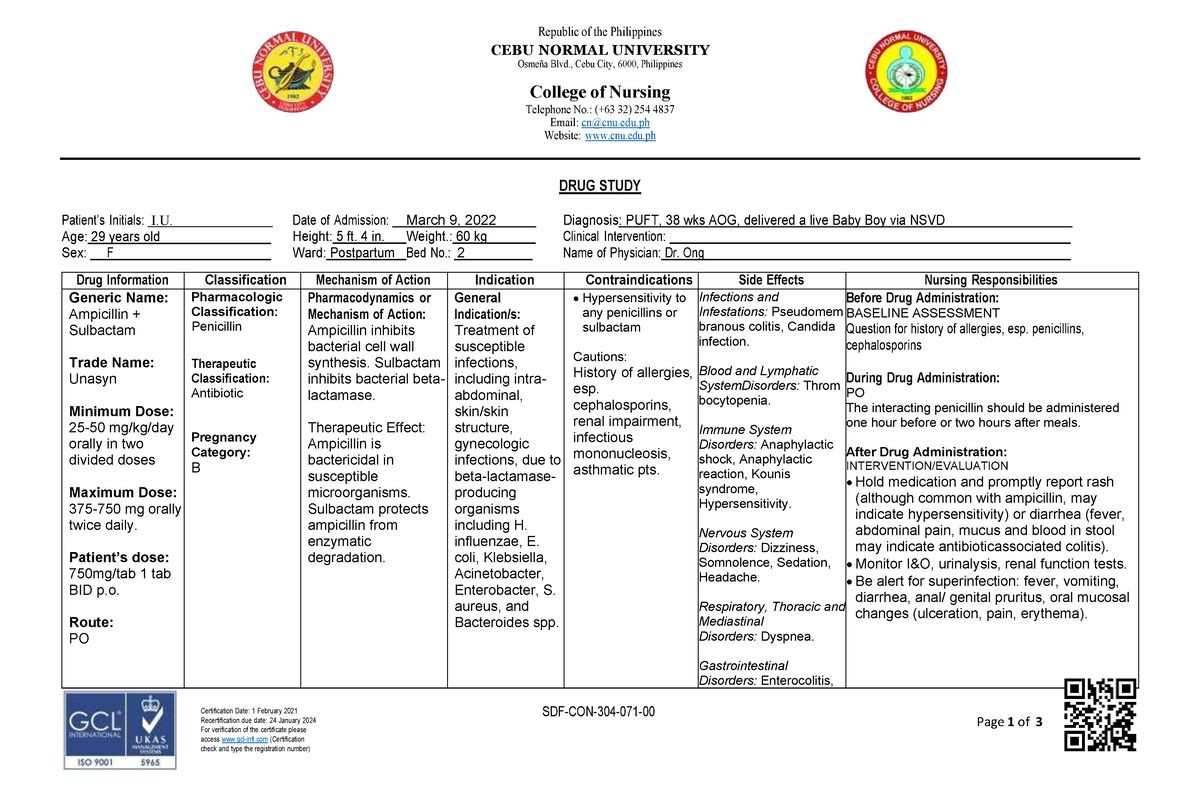
ampicillin/sulbactam – injection, Unasyn
Medication Uses How To Use Side Effects Precautions Drug Interactions Overdose Notes Missed Dose Storage USES: This combination medication is used to treat a wide variety of bacterial infections. It is known as a penicillin-type antibiotic. It works by stopping the growth of bacteria. HOW TO USE: This medication is given by injection into a vein, usually every 6 hours or as directed by your doctor. The dosage is based on your medical condition and response to therapy. For children, the dosage is also based on weight.If you are giving this medication to yourself at home, learn all preparation and usage instructions from your health care professional. Before using, check this product visually for particles or discoloration. If either is present, do not use the liquid. Learn how to store and discard medical supplies safely.Give aminoglycosides (such as gentamicin) separately from this medication. Do not mix together in the same IV fluid.Antibiotics work best when the amount of medicine in your body is kept at a constant level. Therefore, use this drug at evenly spaced intervals.Continue to use this medication until the full prescribed amount is finished, even if symptoms disappear after a few days. Stopping the medication too early may result in a return of the infection.Tell your doctor if your condition persists or worsens. SIDE EFFECTS: Nausea, vomiting, or diarrhea may occur. If this medication is injected into a muscle, pain at the injection site may occur. If any of these effects persist or worsen, notify your doctor or pharmacist promptly.Remember that your doctor has prescribed this medication because he or she has judged that the benefit to you is greater than the risk of side effects. Many people using this medication do not have serious side effects.Tell your doctor right away if you have any serious side effects, including: pain/swelling at injection site (if this drug is injected into a vein), chest pain, difficult/painful urination, easy bruising/bleeding, dark urine, yellowing eyes/skin, severe abdominal/stomach pain, new signs of infection (e.g., fever, persistent sore throat), change in the amount of urine.This medication may rarely cause a severe intestinal condition (Clostridium difficile-associated diarrhea) due to a resistant bacteria. This condition may occur during treatment or weeks to months after treatment has stopped. Do not use anti-diarrhea products or narcotic pain medications if you have any of the following symptoms because these products may make them worse. Tell your doctor immediately if you develop: persistent diarrhea, abdominal or stomach pain/cramping, blood/mucus in your stool.Use of this medication for prolonged or repeated periods may result in oral thrush or a new vaginal yeast infection. Contact your doctor if you notice white patches in your mouth, a change in vaginal discharge, or other new symptoms.A very serious allergic reaction to this drug is rare. However, get medical help right away if you notice any symptoms of a serious allergic reaction, including: rash, itching/swelling (especially of the face/tongue/throat), severe dizziness, trouble breathing.Ampicillin can commonly cause a mild rash that is usually not serious. However, you may not be able to tell it apart from a rare rash that could be a sign of a severe allergic reaction. Therefore, get medical help right away if you develop any rash.This is not a complete list of possible side effects. If you notice other effects not listed above, contact your doctor or pharmacist.In the US -Call your doctor for medical advice about side effects. You may report side effects to FDA at 1-800-FDA-1088.In Canada – Call your doctor for medical advice about side effects. You may report side effects to Health Canada at 1-866-234-2345.
PRECAUTIONS: Before using this medication, tell your doctor or pharmacist if you are allergic to it; or to penicillin or cephalosporin antibiotics; or if you have any other allergies. This product may contain inactive ingredients, which can cause allergic reactions or other problems. Talk to your pharmacist for more details.Before using this medication, tell your doctor or pharmacist your medical history, especially of: viral infections (e.g., infectious mononucleosis), kidney disease.This medication contains sodium. Consult your doctor or pharmacist if you are on a salt-restricted diet or if you have a condition that could be worsened by an increase in salt intake (e.g., congestive heart failure).Kidney function declines as you grow older. This medication is removed by the kidneys. Therefore, elderly people may be at greater risk for side effects while using this drug.During pregnancy, this medication should be used only when clearly needed. Discuss the risks and benefits with your doctor.This medication passes into breast milk. Consult your doctor before breast-feeding. DRUG INTERACTIONS: Drug interactions may change how your medications work or increase your risk for serious side effects. This document does not contain all possible drug interactions. Keep a list of all the products you use (including prescription/nonprescription drugs and herbal products) and share it with your doctor and pharmacist. Do not start, stop, or change the dosage of any medicines without your doctor’s approval.Some products that may interact with this drug include: aminoglycosides (such as gentamicin), "blood thinners" (such as warfarin), live bacterial vaccines, methotrexate, probenecid, tetracyclines.Although most antibiotics probably do not affect hormonal birth control such as pills, patch, or ring, some antibiotics may decrease their effectiveness. This could cause pregnancy. Examples include rifamycins such as rifampin or rifabutin. Be sure to ask your doctor or pharmacist if you should use additional reliable birth control methods while using this antibiotic.This medication may interfere with certain laboratory tests (including certain urine glucose tests), possibly causing false test results. Make sure laboratory personnel and all your doctors know you use this drug. OVERDOSE: If overdose is suspected, contact a poison control center or emergency room immediately. US residents can call their local poison control center at 1-800-222-1222. Canada residents can call a provincial poison control center. Symptoms of overdose may include: seizures. NOTES: Laboratory and/or medical tests (e.g., kidney function, complete blood count) may be performed periodically to monitor your progress or check for side effects. Consult your doctor for more details. MISSED DOSE: For the best possible benefit, it is important to receive each scheduled dose of this medication as directed. If you miss a dose, contact your doctor or pharmacist immediately to establish a new dosing schedule. Do not double the dose to catch up. STORAGE: Consult the product instructions and your pharmacist for storage details. Keep all medications away from children and pets.Do not flush medications down the toilet or pour them into a drain unless instructed to do so. Properly discard this product when it is expired or no longer needed. Consult your pharmacist or local waste disposal company. Information last revised March 2013. Copyright(c) 2013 First Databank, Inc.
QUESTION
Report Problems to the Food and Drug Administration
You are encouraged to report negative side effects of prescription drugs to the FDA. Visit the FDA MedWatch website or call 1-800-FDA-1088.
Selected from data included with permission and copyrighted by First Databank, Inc. This copyrighted material has been downloaded from a licensed data provider and is not for distribution, except as may be authorized by the applicable terms of use. CONDITIONS OF USE: The information in this database is intended to supplement, not substitute for, the expertise and judgment of healthcare professionals. The information is not intended to cover all possible uses, directions, precautions, drug interactions or adverse effects, nor should it be construed to indicate that use of particular drug is safe, appropriate or effective for you or anyone else. A healthcare professional should be consulted before taking any drug, changing any diet or commencing or discontinuing any course of treatment.
Selected from data included with permission and copyrighted by First Databank, Inc. This copyrighted material has been downloaded from a licensed data provider and is not for distribution, except as may be authorized by the applicable terms of use. CONDITIONS OF USE: The information in this database is intended to supplement, not substitute for, the expertise and judgment of healthcare professionals. The information is not intended to cover all possible uses, directions, precautions, drug interactions or adverse effects, nor should it be construed to indicate that use of particular drug is safe, appropriate or effective for you or anyone else. A healthcare professional should be consulted before taking any drug, changing any diet or commencing or discontinuing any course of treatment.


